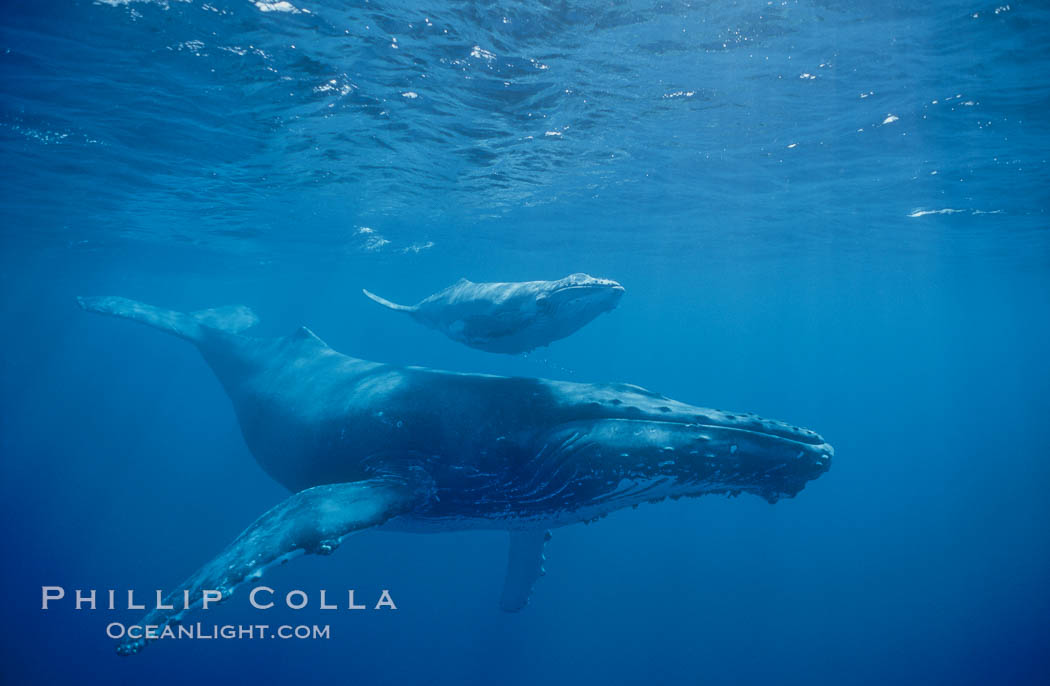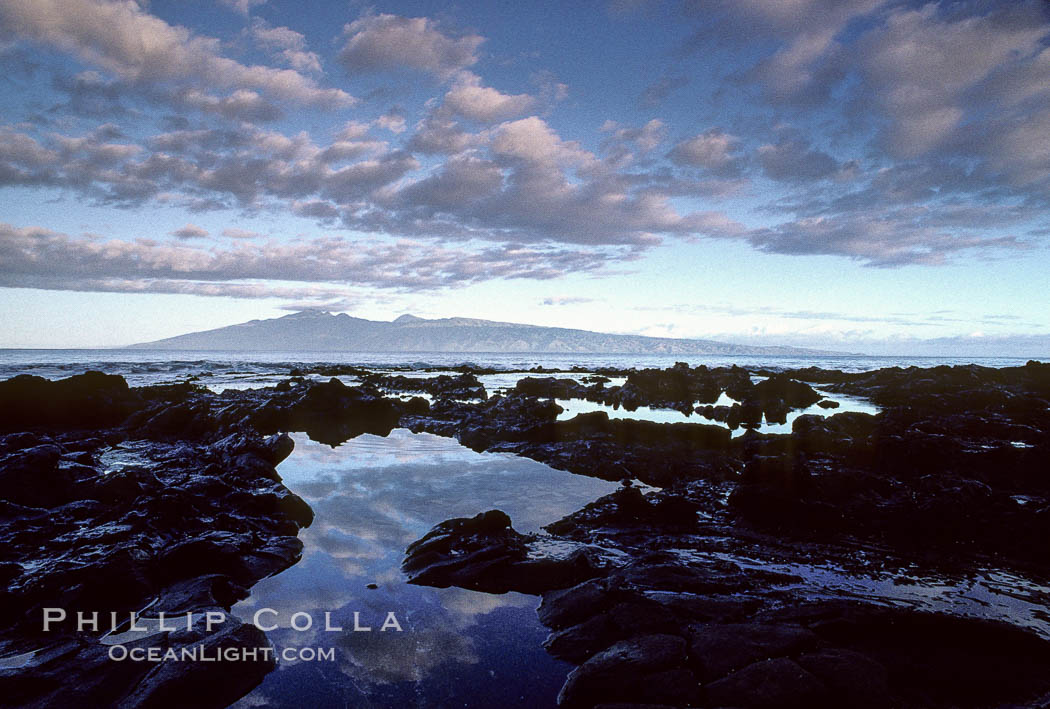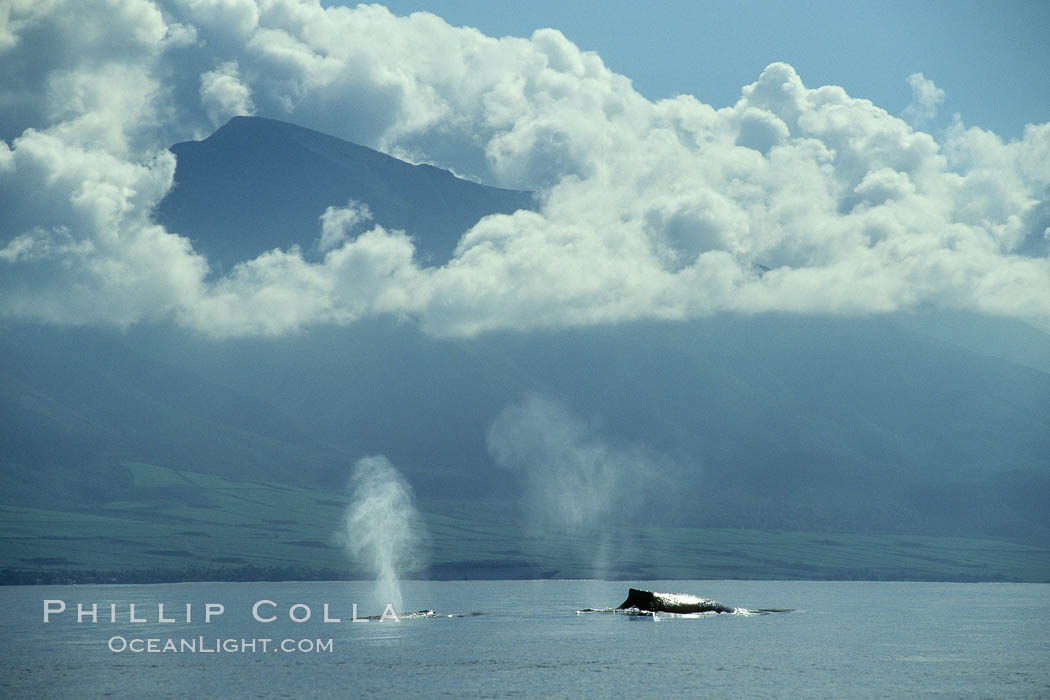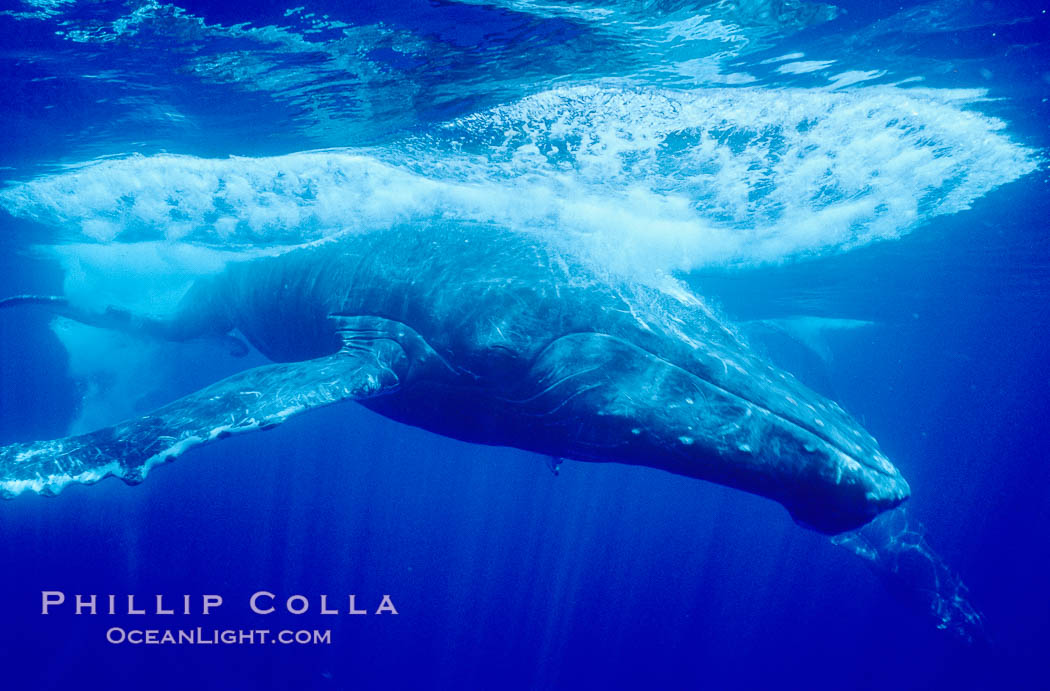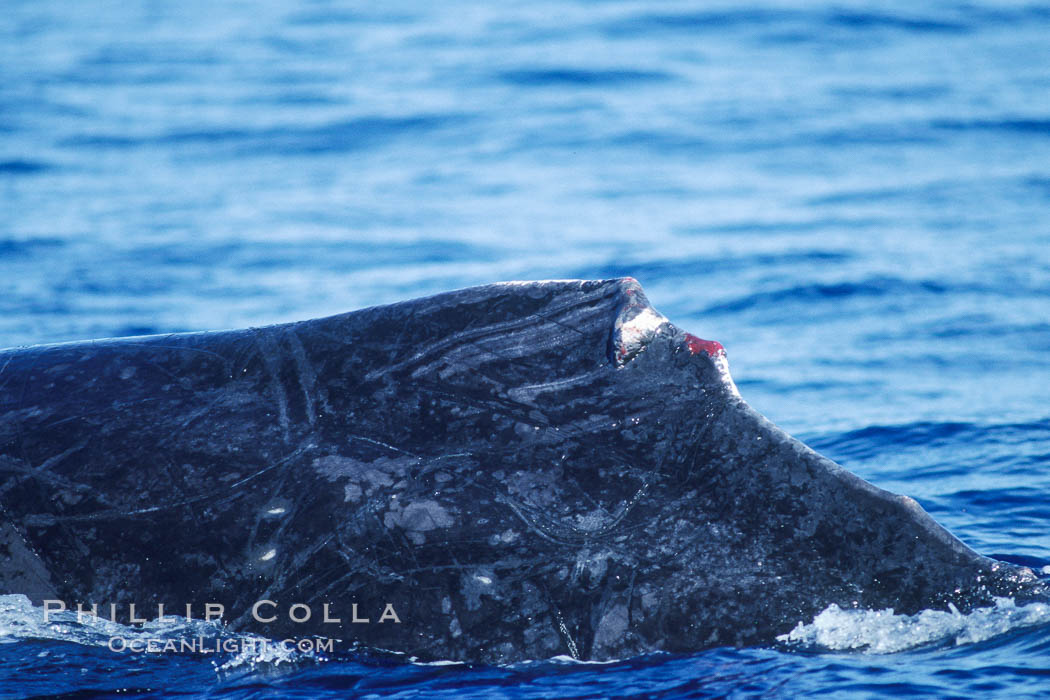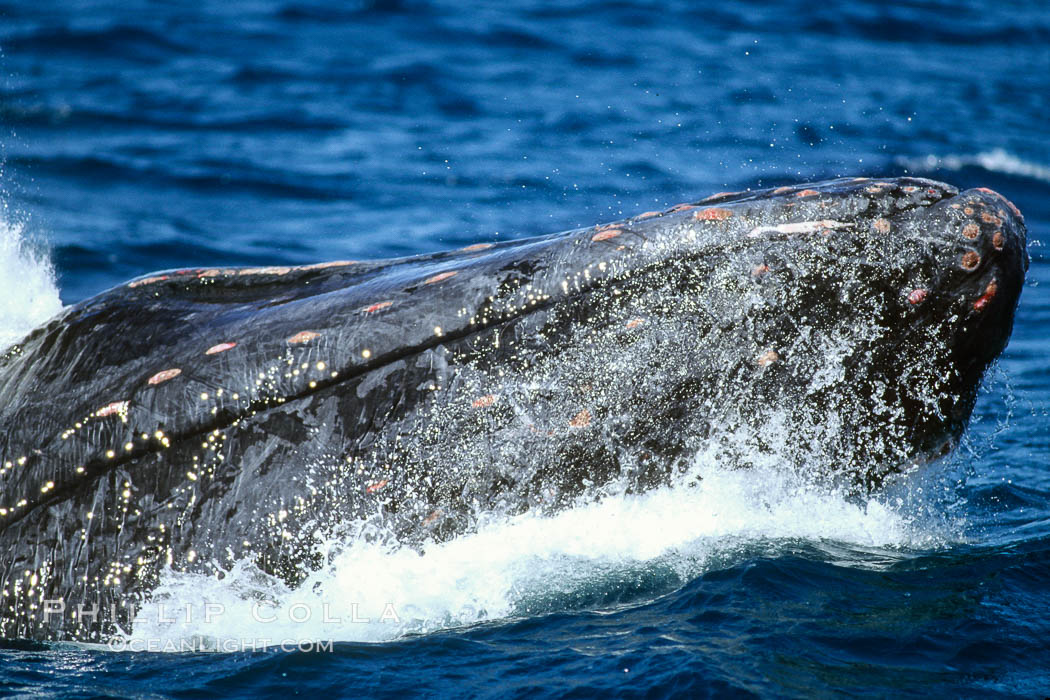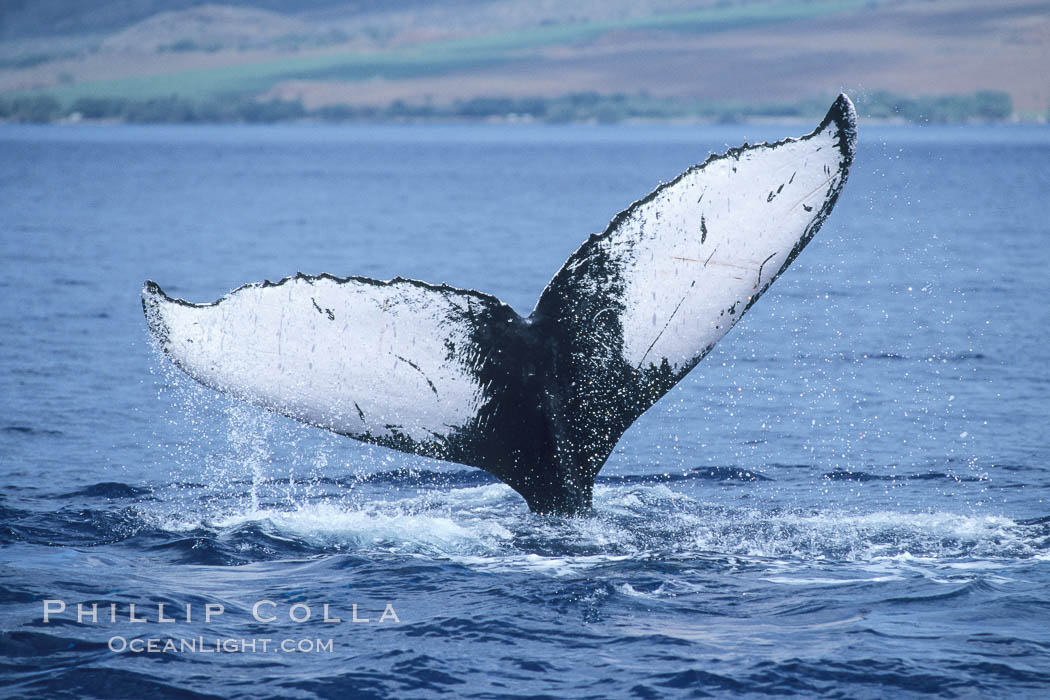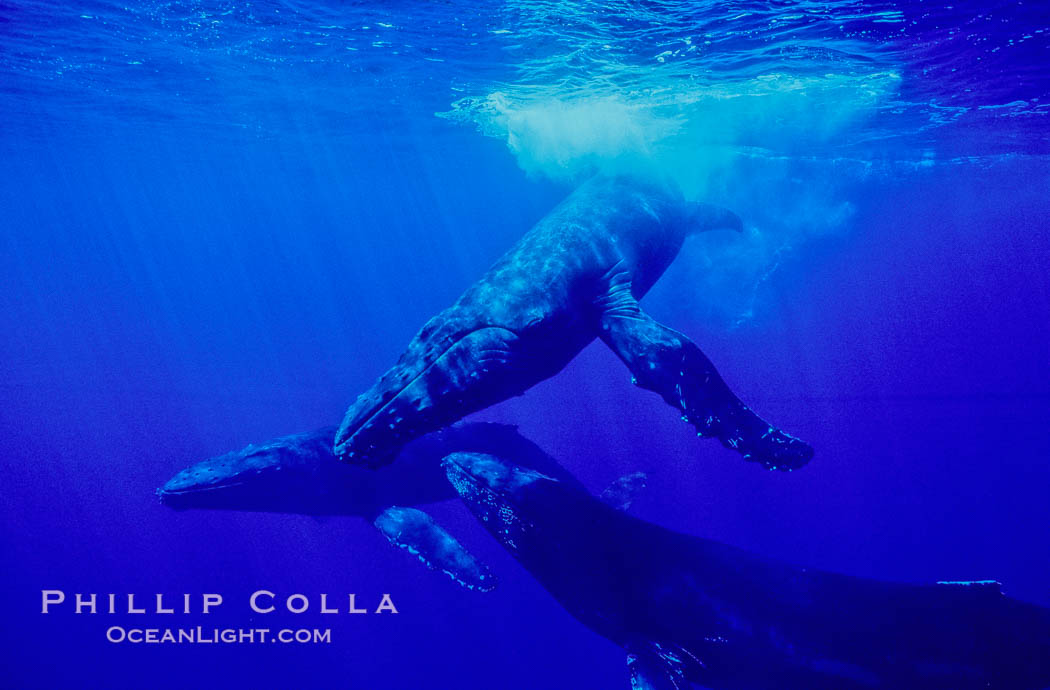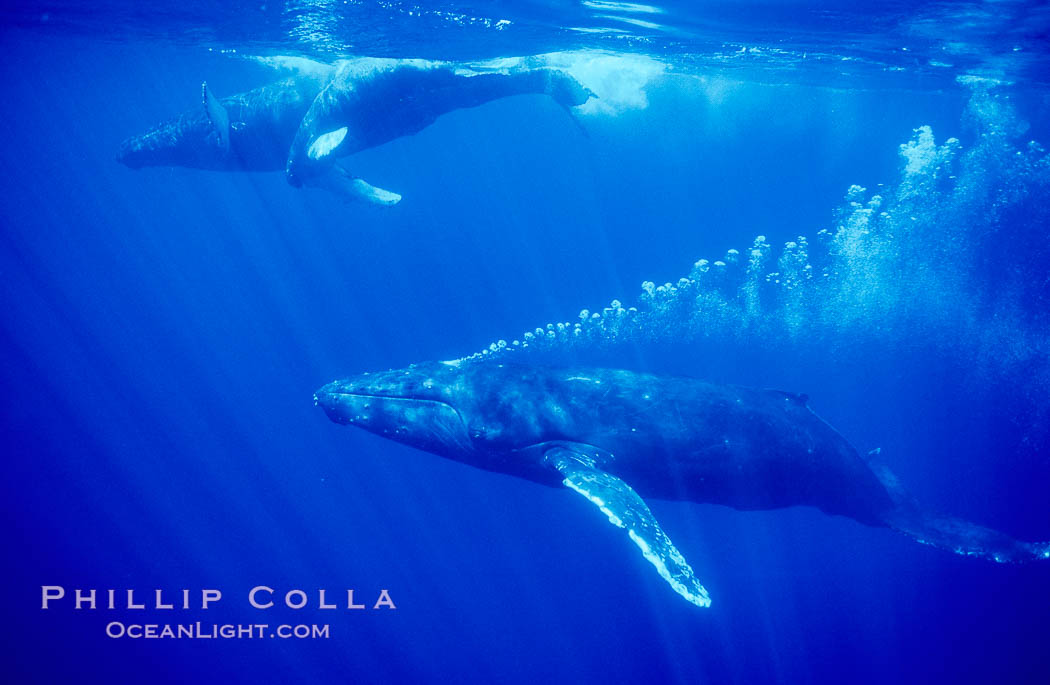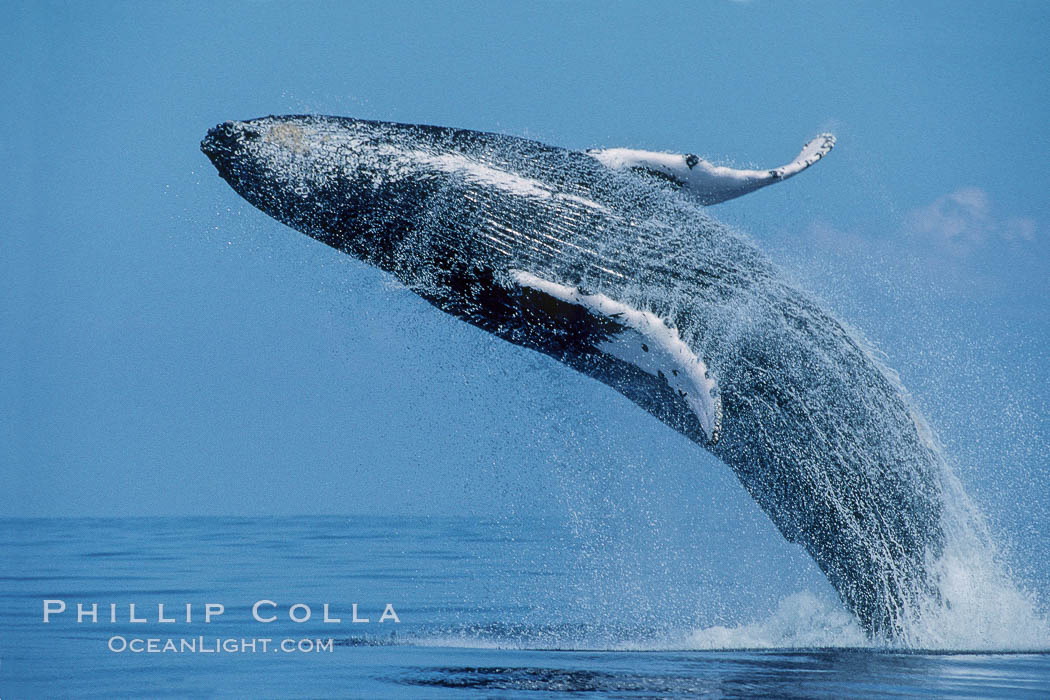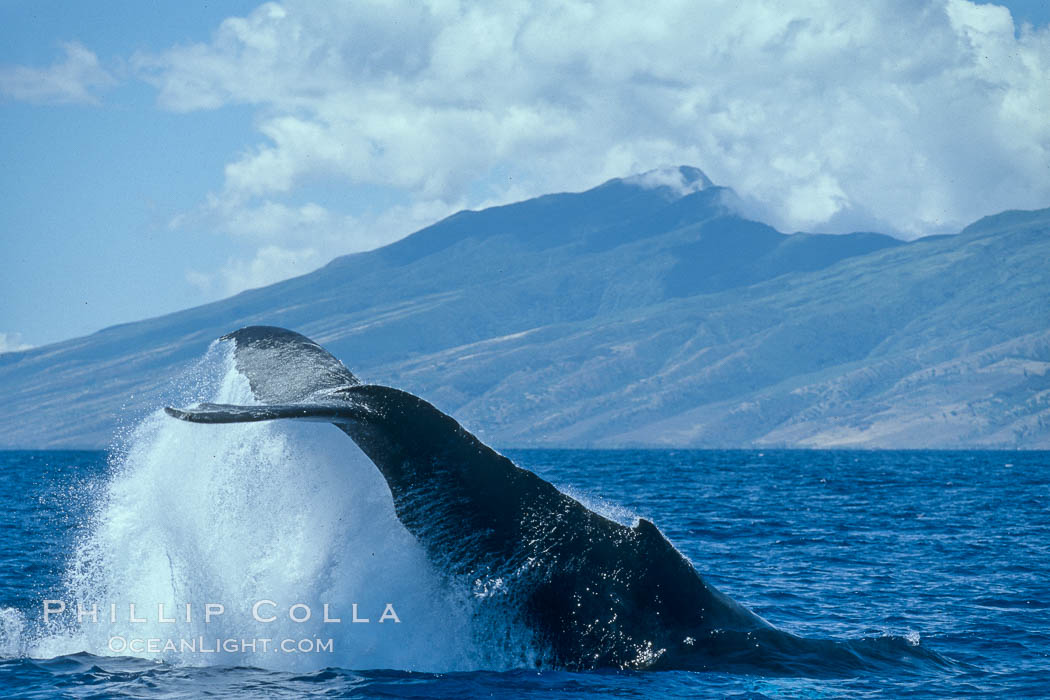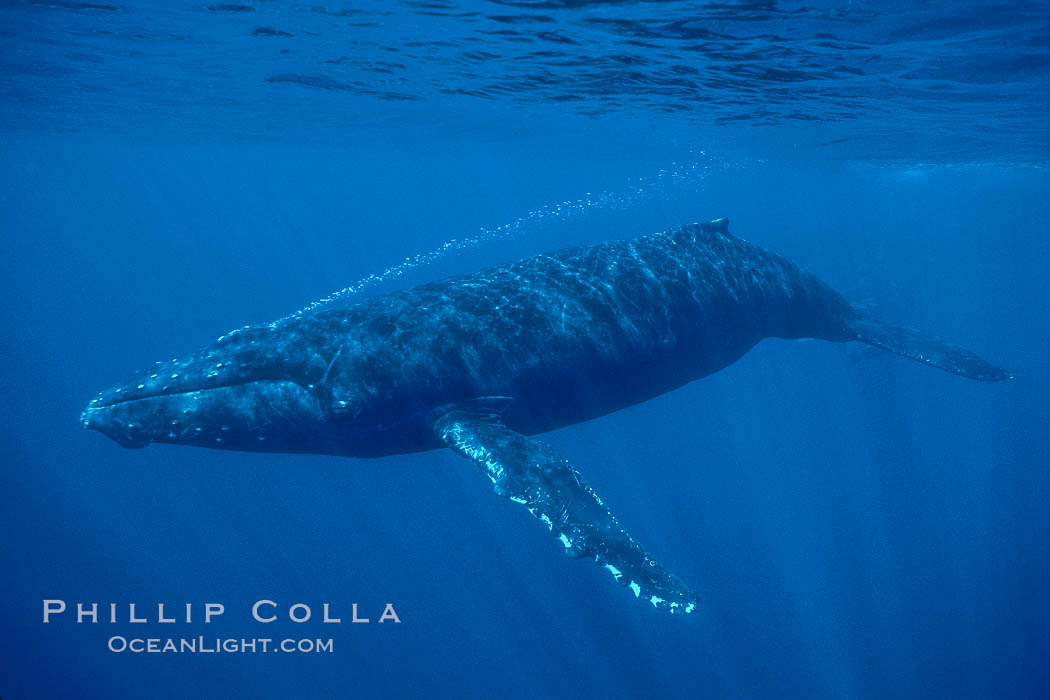Humpback whale underwater photography. Originally titled “Heat Run”, this appeared in Ocean Realm Magazine in April 1995, the first of a series of articles I authored for Ocean Realm in the ’90s.
This blog post is now available as a downloadable PDF article.
Each winter North Pacific humpback whales (Megaptera novaeangliae) converge on Hawaii to calve, form consort pairs and eventually mate. These social activities often culminate in “heat runs”, exciting and only partly understood spectacles of competition unique among cetaceans. It should be pointed out that the term heat run is colloquial suggesting the female whale involved is “in heat” (estrous). In fact there is little direct evidence that estrous is occurring in these events. But since the behaviors involved are thought to be related to courtship and mating, and since heat run continues to be widely used (and not just in Hawaii), I have chosen to leave it in this account. If I were to write this today, I would probably elect to use “competitive group”, “rowdy group” or “surface active group”.
“We’re out of gear.” The props have stopped spinning and humpback pod 1994-181 has surfaced, heading directly toward our research boat. Slipping into the water I immediately sense their presence. An immense deep thrumming sound sets my hair on end, as if I were inside a huge cathedral organ. The mother-calf-escort trio appears 80 feet away and the male escort is singing, a behavior typically observed only in solitary resting males. As the escort glides below, the mother and calf come directly toward me while I hang motionless 15 feet deep. I am awestruck, alone with three enormous humpback whales, all of us breathholding in deep blue water. The mother brings her calf near to examine me, undoubtedly the first human it has seen. I must lift my legs to allow the mother’s 12 foot long pectoral fin to pass underneath. Her calf’s body coloration is just emerging and it is without significant diving ability, staying just below the surface and hugging closely to its mother but on my side, an indication of the mother’s acceptance of me. This calf is so close I could touch it! I take a few photos, recording the whales eyeballing of me as they pass. In contrast to the infant whale’s awkward swimming motions, the mother lifts her fluke in an easy kick, an uncommon opportunity for a tight underwater fluke shot as they move by.
North Pacific humpback whales, a mother and calf pair swim closely together just under the surface of the ocean. The calf will remain with its mother for about a year, migrating from Hawaii to Alaska to feed on herring.
Image ID: 00140
Species: Humpback whale, Megaptera novaeangliae
Location: Maui, Hawaii, USA
Before losing interest and swimming off, pod 181 offered us four more close passes, enough to capture scientifically valuable video images and identifying photographs. In terms of information, this pod provided an ideal encounter. Photographs revealed the mother was previously seen in 1993 in the company of several identified males, one of which could be the father of this calf. This represents a rare potential escort-mother-calf link, a connection important to the study of the long-term social affiliation characteristics of humpback whales. In addition, the male currently escorting the mother in pod 181 may sire her next calf. Beyond the social affiliation implications, pod 181 also symbolized the assumed culmination of a winter social activity among humpbacks known in Hawaii as the heat run, a beautiful, violent and unique phenomenon believed instrumental in determining courtship and mating associations and ultimately resulting one year later in that most characteristic and endearing humpback group, the mother and calf.
Molokai and water pools, viewed from west Maui.
Image ID: 00253
Location: Maui, Hawaii, USA
Once a single land mass of four volcanoes, the islands of Maui, Molokai, Lanai and Kahoolawe now seem like an enormous hand sunken so only the palm and fingertips are visible. Wild and lonely Pacific waters swirl through these fingers and temporarily find calm in the wind lee of Maui, dominated by towering Haleakala volcano and the cloud-ringed West Maui mountains. In this lee, tucked tightly against the coast from Maalaea to Olowalu, humpback mothers regularly bring their new calves to swim in the shallow nearshore waters, to nurse and to gain strength for their coming journey to Alaska. Lanai also has a lee shore where, in addition to mothers and calves, subadult whales are often found socializing, singing and lamenting after being rudely “dropped off” by a mother who has gone to find this year’s mate. But away from shore, calm frequently gives way to weather as the trade winds funnel through the Pailolo channel and streak across Maui’s low-lying midlands into the four island basin, creating shifting windlines that can change glassy calm water into whitecapped swells within minutes. It is here, on the open water among volcanoes and clouds, wind and waves and blazing sun, that Dr. Dan Salden studies the Hawaiian humpback whale.
Humpback whales at the surface, volcano and clouds.
Image ID: 00425
Species: Humpback whale, Megaptera novaeangliae
Location: Maui, Hawaii, USA
Dr. Dan R. Salden steers our small zodiac towards a large pod of surface active whales, at least twelve in number, swimming quickly across the Auau channel. From the strength and frequency of the whales’ distant blows we had earlier determined, while still several miles away, that the animals were exerting themselves tremendously. Positioning the boat alongside and slightly behind the pod, we match speeds with them and begin observing their behavior. Over the past thirty-one years Dr. Salden has mastered the art of approaching humpbacks without disturbing them. When the lead whale blows and makes a shallow dive the rest of the pod follows. Underwater the whales slow, turn and move directly below us. As they return to the surface we find ourselves amid the pod with whales beside, ahead and underneath the boat. Two whales glide just yards below the keel, each almost twice as long as our skiff. One has ghostly white pectoral fins spanning 30 feet tip to tip. The whales are clearly aware of our proximity and make no overtures toward us, exhibiting exceptional body control as they repeatedly pass within feet of the hull while working amongst themselves to establish position. As whales surface to breathe and dive again, we situate ourselves to photograph identifying markings and scars found on the underside and trailing edge of their flukes. These photographs will be matched against the Hawaii Whale Research Foundation’s (HWRF) database of “fluke IDs” in order to establish individual histories and verify repeat sightings. Dan is now truly in his element, photographing new flukes and pleased to recognize animals from past encounters. Their sequential blows are heard over the boat engines, massive exhalations of breath mixed with atomized water and carrying a thick fishy smell. Dan points out the pod’s two focal animals immediately in front of us — the female seems to be dictating the direction of the pod’s travel while flanking her closely is the escort, a whale whose bloody head nodules and scarred, raw dorsal ridge attest to recent violent encounters.
Suddenly a challenging male rushes in from the side, lunging forward and out of the water, its head completely aloft. Crashing its chin down upon the back of the escort, this new whale tries to displace the escort. The challenge has been made, and a “heat run” has begun. Within seconds, the escort parries the challenger’s head lunge with a peduncle throw, a behavior as exciting to observe as a full breach. Converting his forward momentum into a crack-the-whip rotation, the escort pivots about his submerged head, thrusting his entire fluke and peduncle (the muscular rear portion of his torso) out of the water and laterally at the challenger. An opening behind the female forms as the fighting males move away from the rest of the pod. Before a lesser challenger can fill the gap, the female slows and waits for the escort to rejoin her. Whales begin trumpeting loudly as they surface to breathe, a series of rolling “harumph-umph-umph” sounds that may be attempts at intimidation or simply the result of strenuous exertion. Additional challengers draw in tightly behind the escort, determining among themselves who gets to make a new challenge when the current conflict is resolved. The escort repeatedly blocks the primary challenger, actually pushing him sideways across the surface, then quickly resumes his position beside and behind the female to await his adversary’s next move. Giving up after several failed attempts to displace the escort, the primary challenger breaks off from the pod and departs. Another whale in the pod, who has perhaps been waiting “its turn”, takes his place and the battle continues.
North Pacific humpback whale, escort in competitive group makes fast close pass.
Image ID: 06057
Species: Humpback whale, Megaptera novaeangliae
Location: Maui, Hawaii, USA
The “heat run” is a setting for spectacular acrobatics and provides an opportunity to study the humpback courtship process. The focus of the run is usually an adult female although there are all-male surface active groups. Typically she is without calf and swimming at speed so that the males pursue quickly, close to the surface. As the season progresses and calves appear more frequently, we encounter runs in which the pace is slowed by a mother with her calf. (In 1993 we observed a surface active group that formed around a sleeping mother / calf pair.) Today, the female is without a calf and has allowed an adult male to accompany her. This escort flanks her continually hoping ultimately to mate with her, wary of others who wish to usurp his position. Staying ahead of the female and escort and careful to keep out of the fray are three subadult whales just a few years old, not challenging the escort but instead apparently just observing the adult’s behavior in anticipation of their own future roles one day.
Humpback whale dorsal fin damaged during competitive group socializing.
Image ID: 04334
Species: Humpback whale, Megaptera novaeangliae
Location: Maui, Hawaii, USA
The escort’s principal concern is a lineup of challenging males spread out behind him. Each challenger may attempt to displace him from his position with the female. Challenges are an escalating series of maneuvers that may stop at intimidation or culminate in physical injury. On rare occasions Dr. Salden has observed cooperation among challengers, teaming up to defeat the escort. Lesser challengers often engage in side skirmishes among themselves away from the pod, perhaps to establish a pecking order. A successful challenger may become the new escort if the female is accepting and if he can resist further challenges. Determining the gender and roles of the female, escort and seasoned challengers in an active group is straightforward: unlike the smooth skin of females who do not battle, adult males who have accumulated the skill and strength to challenge are scarred and often display dorsal fins that are merely stumps, sheared off by a past opponent’s attack. The dorsal ridge (the backbone leading from the dorsal fin to the fluke) is usually carved with gouges, rips, and white scars, grim testaments to the effectiveness of a humpback whale’s barnacle-encrusted chin as a hammering weapon.
North Pacific humpback whale, adult male with bloody head nodules wounded from colliding with other escorts during competitive interactions.
Image ID: 02152
Species: Humpback whale, Megaptera novaeangliae
Location: Maui, Hawaii, USA
Interpreting heat run events from a boat can be difficult, especially with a large pod. The role of animals not directly involved in the conflict is unclear, and the gender of younger whales cannot be determined from superficial scarring. The role of each challenger is fluid, with males jostling for optimal position relative to the female. Whales with white pectoral fins are the most distinguishable underwater, even when 50-80 feet deep. Some individuals have other distinguishing features, such as dorsal fins — hooked, pointed, stumped or gouged — that are visible whenever they break the surface. The rest are usually known only by their fluke patterns, any unusual scarring, or perhaps by their maintaining a constant position in the pod throughout the run.
Humpback whale fluking up, ventral aspect of fluke visible.
Image ID: 04150
Species: Humpback whale, Megaptera novaeangliae
Location: Maui, Hawaii, USA
When the whales have long down times we must enter the water with them to better witness how the skirmish is resolving itself. Allowed under HWRF’s research permit, underwater study offers opportunities to more fully assess the sex and social roles of key animals and to observe chance behaviors such as nursing and penile displays. (Although whales have internal genitalia, gender can be determined by observing the genital slit and surrounding features, located on the ventral peduncle anterior to the fluke.) Given a change in direction that results in the pod swimming toward the boat, Dan stops for us to enter before moving the boat out of the whales’ path. Only free diving equipment is used and special care is made to minimize water disturbance and to remain unobtrusive. Once the animals are in sight we swim parallel to them and do not dive below them unless they have already shown that they fully accept our presence in the water. For the fortunate few researchers allowed in the water these are often the most rewarding moments of our work, occasions to observe up to a dozen 40-ton whales at once, racing and jostling and flying by.
North Pacific humpback whales, socializing trio of adults.
Image ID: 05933
Species: Humpback whale, Megaptera novaeangliae
Location: Maui, Hawaii, USA
Getting away from the departing boat’s prop wash is nerve-wracking — whales will be here in moments and I cannot see through the bubbles. Once into clear water I make out the female, leading the pod with four others some 50 feet behind her. Their sounds are a wild dissonance of low pitched calls quite different from the orderly singing of resting males. If they see me, as the female and two of the others do, the whales usually cruise by without changing their behavior. It is amazing to see them corkscrew in order to position both eyes for a stereoscopic view of me. The low contrast of grayish whale against blue water makes it difficult to see all the animals, especially some that pass behind or below. Battling whales that do not see me are a danger and I stay ready to move out of their path. The escort and primary challenger are now drawing near and are intent on one another, flukes pumping and heads driving furiously against each other. Diving, they leave a roiling footprint on the surface and pass within a body length of where I float. The escort has the advantage of bearing down on the challenger from above, pushing with his rostrum and using his pectoral fins to maintain position, while the challenger manages to twist and lash at the escort’s body with lateral fluke swipes. Although the combatants have not actively sought food since leaving Alaska in January, they are expending enormous amounts of energy. I feel insignificant in comparison. When they have faded from sight all that remains is a bubble trail that one whale left behind, a three hundred foot long contrail glistening in the sun, rising silently to the surface.
North Pacific humpback whale, male escort bubble streams alongside mother and calf.
Image ID: 05926
Species: Humpback whale, Megaptera novaeangliae
Location: Maui, Hawaii, USA
Whales constantly enter and exit heat runs, some of which last an entire day. Distant animals may hear the activities and rush over to investigate. Defeated challengers and disinterested subadults often veer off and disaffiliate, perhaps later to breathhold (rest) or sing. On several occasions we observed two surface active pods cross paths. In the ensuing chaos whales shuffle between pods and wholesale changes in a pod’s temporal social hierarchy may occur.
In one sense, a breach is any behavior in which a substantial portion of the whale breaks the surface. But in practice, a breach is considered to be that most dramatic of events, when the whale launches itself headfirst out of the water with such force it becomes almost entirely airborne. Breaching associated with the heat run most often occurs when a humpback affiliates (joins the pod) or disaffiliates. In addition to the possibility that whales are visually scanning their environment while breaching, Dr. Salden feels the breach has a communication function as well, an opinion shared by other researchers and formulated from years of anecdotal observations. An expert in nonverbal communication, Dr. Salden suspects breaching is the humpback’s way of announcing It is I!, with any surrounding activities forming a context in which the breach must be interpreted. It may be an aggressive signal from an arriving whale (It is I, watch out!) or a parting shot from a disaffiliating whale (Remember me!). When accompanied by a breach, whatever the whale is communicating is “said” with emphasis. An adult whale’s full breach is the most exciting singular behavior humpback observers see. A mighty launch rockets 45 tons of twisting whale skyward, pectoral fins flinging sheets of water aside, ending in a slow motion body slam heard for great distances.
North Pacific humpback whale, breach.
Image ID: 00205
Species: Humpback whale, Megaptera novaeangliae
Location: Maui, Hawaii, USA
Underwater, a full breach is a frightening thunderclap, a painfully sharp crack. Captain Jill Mickelsen and I experienced a particularly memorable breaching session one day while in the water observing a mother-calf-escort trio off the north shore of Lanai. Strangely, as the mother and calf slowly circled us, the escort unleashed a succession of more than 25 breaches quite close to our boat. Wind chop, combined with his splashes, reduced the water visibility to less than 60 feet, forcing Jill and I to search continually for the escort deep below as he prepared to rush upward for his next launch. Occasionally, we could see him spiraling and pumping as he approached the surface and we could signal to the boat where he would emerge. More often we would simply hear his breach and realize gratefully that he did not land on us. Researcher David Glickman was able to capture these breaches in a video record that shows the escort slamming one pectoral fin against the water each time he landed, as if to add to his impact. He eventually stopped after the mother directed several peduncle throws at him. Did she tire of his show, or was her calf becoming distressed? No sooner was the breaching finished than Galapagos sharks appeared, swimming erratically with pectoral fins lowered. Had they been attracted by the surface activity or had the breaching been directed at them as a warning? In either case, we were swimming in waters filled with many large pieces of humpback skin shed during the melee — a whale-scented chum line! Four sharks quickly approached me from below, nipping at my fins. I have been told a video camera was still recording as I yelled for the boat and scrambled aboard, rattled.
North Pacific humpback whale, peduncle throw.
Image ID: 02153
Species: Humpback whale, Megaptera novaeangliae
Location: Maui, Hawaii, USA
It is in large surface active pods that the potential for a heat run lies and that courtship roles become clear, although no direct evidence linking such social behavior to mating has yet been found. In-water observations allow us to examine facets of behavior not observable from the boat, including actions carried out in conjunction with social sounds. Courtship, mating and birthing activities likely occur in the North Pacific humpback wintering areas of Hawaii, Japan and Mexico. Still, the reproductive lives of humpbacks remain a mystery. Do humpbacks mate in Hawaii or on the journey back to Alaska? Where are the calves born, in sheltered waters or open ocean? Although we have recorded an uncommon underwater humpback penis display and analyzed a sample of humpback placenta, no confirmed direct observation of either mating or calving has been recorded. Pods exhibiting courtship behavior are thus valuable as they provide information about which whales are together this year, in anticipation of calves next year. These data will help us to answer broader questions about whether humpbacks form long-term social affiliations and what factors might influence such relationships.
The Hawaiian Islands Humpback Whale National Marine Sanctuary, designated by Congress in 1992, specifically recognizes the importance of the humpback whale and its winter habitat and will promote protection, research and education while monitoring both the whale and its Hawaiian environment. The Hawaii Whale Research Foundation studies humpback social affiliation and communication with the belief that if the behaviors of these magnificent animals are more fully understood, we may better offer recommendations that protect and preserve them. HWRF was founded and is directed by Dan R. Salden, Ph.D., past chair of the Department of Speech Communication at Southern Illinois University at Edwardsville. HWRF maintains a growing database of individually identified North Pacific humpback whales, including some that are known to winter in Japan and Mexico as well as Hawaii, and a video record documenting humpback behavior and social roles. HWRF is a publicly supported nonprofit organization staffed by a small group of volunteers. Five winter months of data collection and photo-documentation in Hawaii are augmented by year-round analysis, scientific publications, public service seminars and educational presentations. Field studies are governed by the provisions of NOAA Fisheries (aka, National Marine Fisheries Service) and State of Hawaii scientific research permits.
North Pacific humpback whale.
Image ID: 00167
Species: Humpback whale, Megaptera novaeangliae
Location: Maui, Hawaii, USA
More information about Dr. Dan Salden and Hawaii Whale Research Foundation can be found on HWRF’s website.
As he has with all of my past articles, Skip Stubbs offered important advice.
Some humpback whale behaviors often observed in association with surface active groups (heat runs):
Breaching
Underwater bubble displays
Mother / calf pairs
Lunging
Peduncle throws and tail lobs
Pectoral fin displays
Crucifix blocking
Keywords: humpback whale, megaptera novaeangliae, surface active, behavior, rowdy group, maui, hawaii, pacific.
